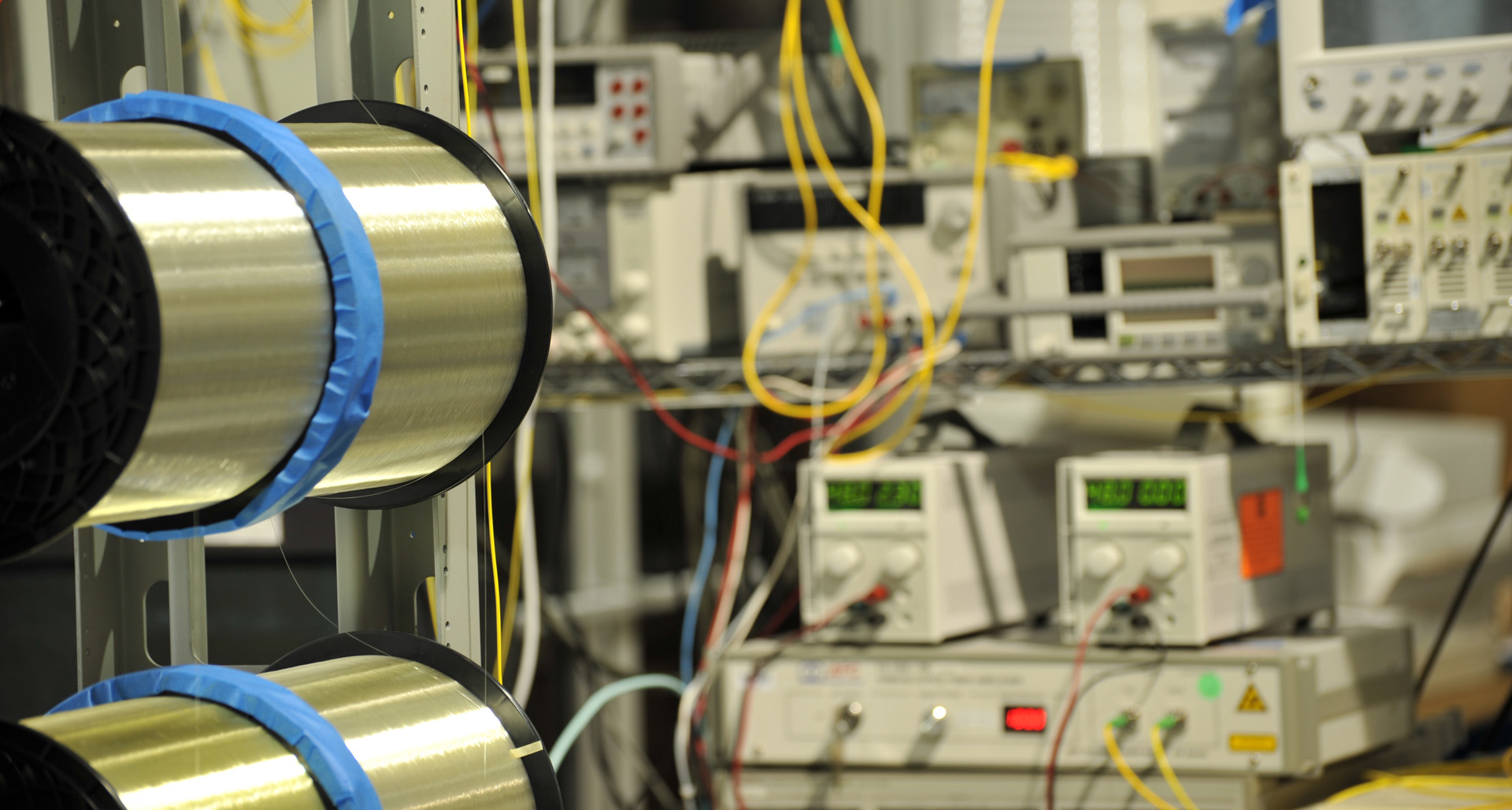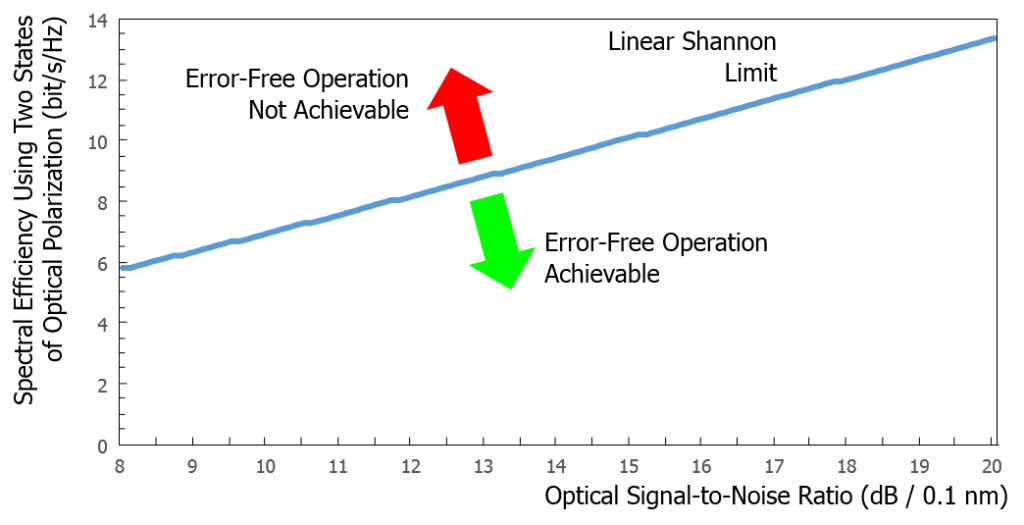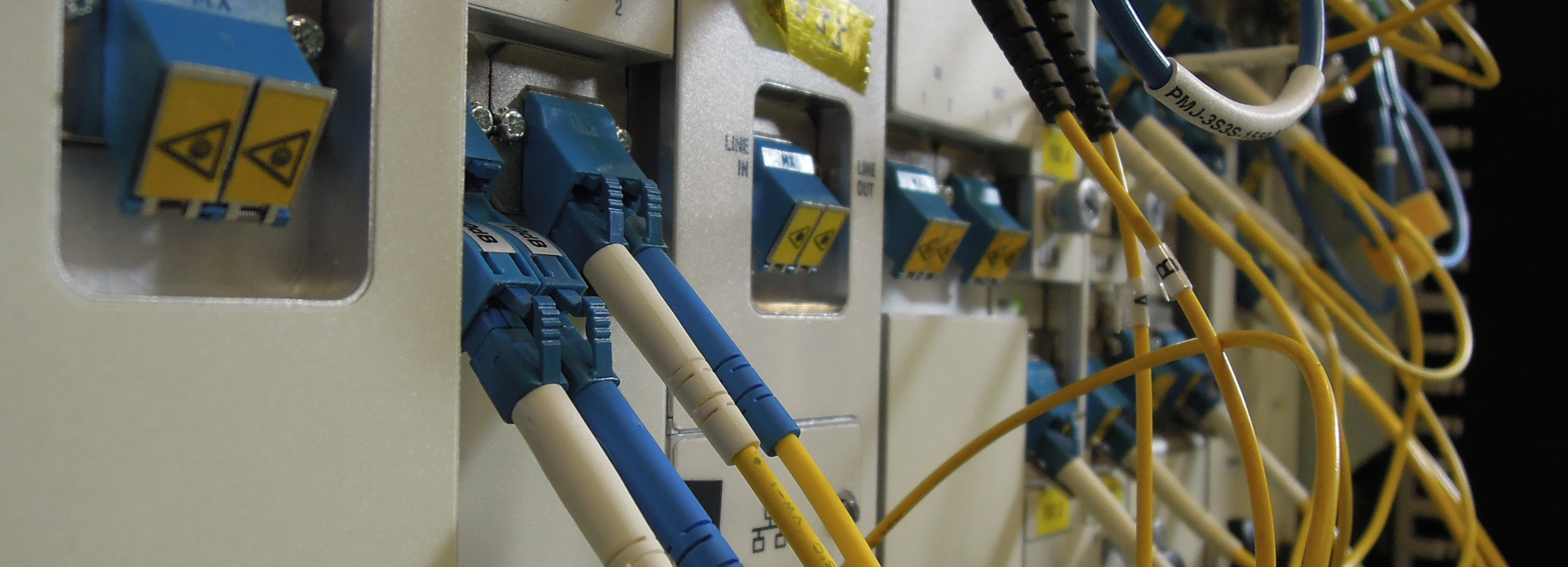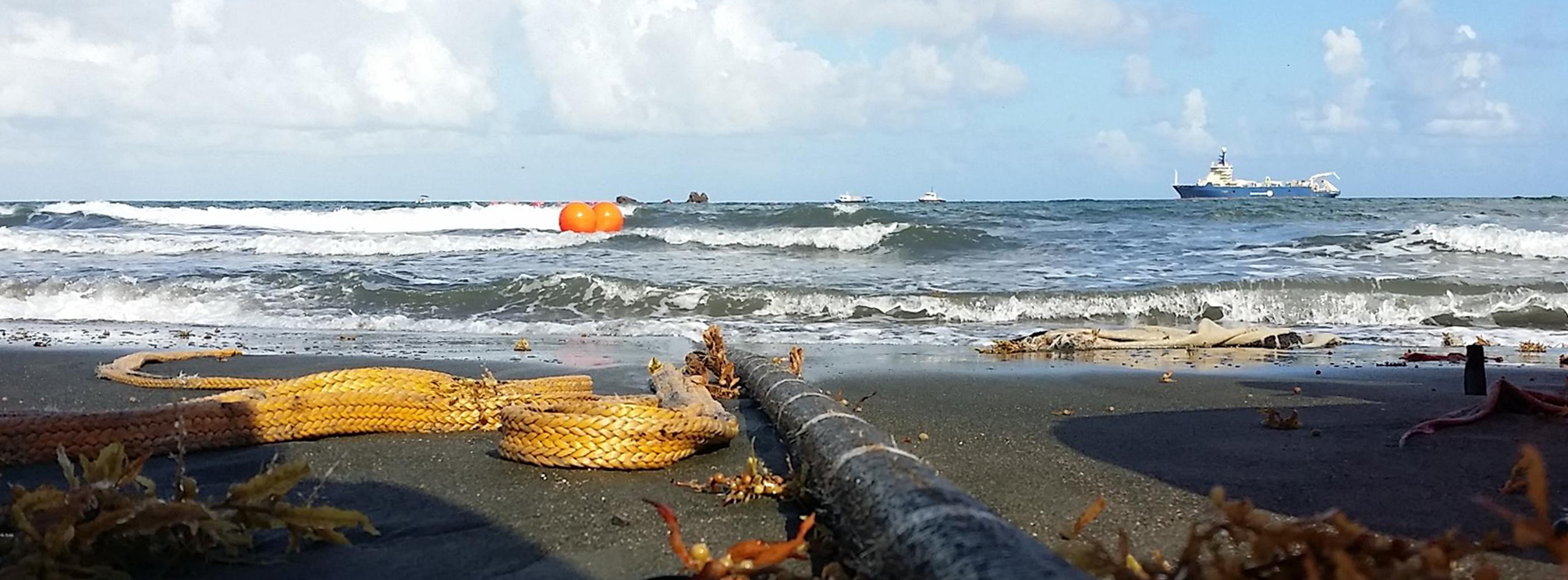This post reviews the latest results from laboratory demonstrations and field trials for increasing further subsea cable system capacity (and spectral efficiency) on a per fiber basis. Before taking a look at the most recent and meaningful results, we will have first a quick glance at what governs (and limits) the capacity per fiber, the so-called Shannon limit.

Shannon Limit Drives Maximal Capacity
The Shannon-Hartley theorem tells the maximal rate at which information can be transmitted with zero error, using ideal error-correcting code, over a communication channel of a specified bandwidth in the presence of additive white Gaussian noise:

where
- C is the channel capacity in bits per second, a theoretical upper bound on the net bit rate (information rate) excluding overhead for error-correction codes;
- B is the bandwidth of the channel in hertz;
- S is the average received signal power over the bandwidth, measured in watts;
- N is the average power of the noise and interference over the bandwidth, measured in watts; and
- S/N is the Signal-to-Noise Ratio (SNR) of the communication signal to the noise and interference at the receiver in the bandwidth of the signal (expressed as a linear power ratio, not as logarithmic decibels).
This upper limit applies to any transmission channel (free space, twisted-pair wire, coaxial cable, etc.). In the case of optical fiber transmission, a communication channel must be understood as, e.g., a state of optical polarization, a fiber core or a fiber mode.

Shannon Limit Also Drives Maximal Spectral Efficiency
Spectral Efficiency (SE) refers to the information rate, expressed in bit/s, that can be transmitted over a given bandwidth in a specific communication system based on a given communication channel. Spectral efficiency is obtained by dividing the channel information rate by the channel bandwidth.
This is a measure of how efficiently a limited frequency spectrum (like the optical bandwidth offered by subsea cable system repeaters) is utilized by the optical transport technologies (found for instance inside line terminal equipment). Spectral efficiency is expressed in bit/s/Hz (or more unambiguously in (bit/s)/Hz). In the same way that the Shannon limit caps the information rate that can be transmitted with a specified bandwidth in the presence of additive white Gaussian noise, the Shannon-Hartley theorem also caps the spectral efficiency in the presence of noise:

Advances in optical transmission technologies, coding, signal processing and forward error correction codes allow optical networks to transport higher and higher capacity and operate closer and closer to Shannon spectral efficiency limit.

Linear Shannon Limit Curve in Coherent Optical Networks
Modern coherent optical networking equipment uses the optical polarization multiplexing “trick” (see our New modulation format tutorial). This technique effectively doubles the amount of data transmitted by a single laser source (emitting a single wavelength) to effectively double the spectral efficiency (as there is no spectral broadening).
This is the reason why the Shannon limit is often graphically represented accounting the two states of optical polarization. The plot below shows the linear Shannon limit over the practical OSNR range of interest where most of the coherent optical networks operate, considering both states of optical polarization.

An optical link designed with an OSNR of 13 dB can theoretically allow error-free operation with a spectral efficiency as high as 8.8 bit/s/Hz. The first transmission experiments were far from this figure: for instance, the best laboratory demonstrations 7 years ago achieved only about half of the maximal achievable spectral efficiency.

Laboratory Demonstrations for Higher Subsea Cable System Capacity
This section presents a recent selection of lab experiments about long-haul, ultra-high-capacity transmission along subsea cable systems reported in technical conferences or published in peer-reviewed technical journals since the beginning of year 2017. Out of the five lab demonstrations summarized below, two of them make use of C band EDFA amplification scheme while the other three ones rely on C+L band EDFA repeaters. For each of the works, the main technologies involved in reaching the Capacity / Reach results are summarized, while the results themselves are reported in terms of total capacity, spectral efficiency and transmission distance. The five lab demonstrations below are listed in chronological order.
Capacity-Approaching Transmission Over 6,375 km Using Hybrid Quasi-Single-Mode Fiber Spans (NEC – JLT – February 2017)
- Fiber spans: 56.1-km / 8.9-dB span (26.1 km at 176 μm2 / 0.163 dB/km and 30 km at 150 μm2 / 0.153 dB/km)
- Repeaters: 4.2 THz bandwidth of C-band EDFA (1529.75 – 1563.05 nm), with +20 dBm total output power launched into the line fiber
- Channels: 168 x 208 Gbit/s channels spaced at 25 GHz, modulated at 24.8 Gbaud
- Modulation format: 64APSK (Amplitude-Phase Shifted Keying)
- Average received Optical Signal-to-Noise Ratio (OSNR) is about 21 dB / 0.1 nm with <1 dB tilt across the C band.
- 34.9 Tbit/s at 8.3 bit/s/Hz over 6,375 km
70.4 Tb/s Capacity over 7,600 km in C+L Band Using Coded Modulation with Hybrid Constellation Shaping and Nonlinearity Compensation (TE SubCom – OFC 2017 – March 2017)
- Fiber spans: 52.8-km / 7.92-dB fiber spans with 0.150 dB/km loss and ~150 μm2 effective area
- Repeaters: 9.74 THz bandwidth of C+L EDFA, with +22.5 dBm total output power launched into the line fiber
- Channels: 295 x 239 Gbit/s channels spaced at 33 GHz, modulated at 32.6 Gbaud
- Modulation format: 56APSK (Amplitude-Phase Shifted Keying)
- Average received OSNR is about 20.2 dB / 0.1 nm with 1.8 dB tilt across C and L bands.
- 70.4 Tbit/s at 7.23 bit/s/Hz over 7,600 km
Advanced C+L-Band Transoceanic Transmission Systems Based on Probabilistically Shaped PDM-64QAM (Nokia Bell Labs – JLT – April 2017)
- Fiber spans: 55-km / 8.6-dB span (150 μm2 / 0.157 dB/km). The total span loss, including fiber, C/L-demultiplexer, connectors and splicing loss was 10.2 dB.
- Repeaters: 8.9 THz bandwidth of C+L EDFA, with +22 dBm total output power launched into the line fiber
- Channels: 179 x 363.1 Gbit/s channels spaced at 50 GHz, modulated at 49 Gbaud
- Modulation format: PS64QAM (Probabilistically-Shaped 64QAM)
- Average received OSNR is about 11 dB / 0.1 nm with 2 dB tilt across C and L bands.
- 65 Tbit/s at 7.3 bit/s/Hz over 6,600 km
- Comments:
- Very, very close to the Shannon limit.
- Note: Average net data rate of 363.1 Gbit/s per 50 GHz channel slot for a full-band transoceanic lab demonstration!
Near Capacity 24.6 Tb/s Transmission over 10,285km Straight Line Testbed at 5.9 b/s/Hz Spectral Efficiency Using TPCS-64QAM and C-Band EDFA-Only (ASN – ECOC 2017 – September 2017)
- Fiber spans: 54.4-km span at 110 μm2 (no loss information)
- Repeaters: 4.2 THz bandwidth of C-band EDFA (1529.75 – 1563.05 nm), with +16.6 dBm total output power launched into the line fiber
- Channels: 84 x 293 Gbit/s channels spaced at 50 GHz, modulated at 49 Gbaud
- Modulation format: Truncated Probabilistic Constellation Shaping 64QAM (TPCS-64QAM).
- Average received OSNR is about 9.3 dB / 0.1 nm with 1 dB tilt across the C-band.
- 24.66 Tbit/s at 5.9 bit/s/Hz over 10,285 km
- Comment: very close to the Shannon limit!
51.5 Tb/s Capacity over 17,107 km in C+L Bandwidth Using Single Mode Fibers and Nonlinearity Compensation (TE SubCom – ECOC 2017 – September 2017)
- Fiber spans: 52.8-km / 7.92-dB fiber spans with 0.150 dB/km loss and ~150 μm2 effective area
- Repeaters: 9.74 THz bandwidth of C+L EDFA, with +22.5 dBm total output power launched into the line fiber
- Channels: 295 x 175 Gbit/s channels spaced at 33 GHz, modulated at 32.6 Gbaud
- Modulation format: 40APSK (Amplitude-Phase Shifted Keying)
- Average received OSNR is about 16.3 dB /0.1 nm with 2.1 dB tilt across C and L bands.
- 51.5 Tbit/s at 5.29 bit/s/Hz over 17,107 km
Two important points to make here:
- First, there was no record lab results reported in 2018 for experimental breakthrough in high-capacity transport over transoceanic subsea lengths;
- Second, the lab demonstrations reported above rely on many complex technical tricks, including:
- Multi-dimensional coded modulation
- Hybrid (geometrical and probabilistic) constellation shaping
- Adaptive-rate FEC decoding
- Multi-stage digital nonlinearity compensation
- Adaptive-rate spatially-coupled low density parity check (SC-LDPC)
It looks like technology is reaching some kind of plateau as far as fiber capacity per bandwidth unit is concerned. The gap with the Shannon limit is today small, and it will require even more complex and expensive technologies/devices to narrow further this gap for very limited capacity gains.

Field Trial Demonstrations
In parallel to lab demonstrations, we have seen several field trials in the past two years aiming at assessing the capacity performance of long-haul subsea cable systems that were designed 3 to 5 years ago. These field trials are based on (more or less) commercially-available products, offering stable, commercial-ready performance margin. Not all the field trials reported below were presented in technical conferences or journals so fewer technical details are available than for lab demonstrations. The six field trials below are listed chronologically.

Trans-Atlantic Field Trial Using Probabilistically Shaped 64-QAM at High Spectral Efficiencies and Single-Carrier Real-Time 250-Gb/s 16-QAM (Nokia Bell Labs / Facebook – OFC 2017 conference – March 2017)
- Field trial over transatlantic AEC-1 subsea cable system (wet plant supplied by TE SubCom)
- Fiber spans: 89-km / 14.4-dB span at 130 μm2 and 0.156 dB/km
- Repeaters: 4.3 THz bandwidth of C-band EDFA, with +19 dBm total output power launched into the line fiber
- Channels: 69 x 250 Gbit/s channels spaced at 62.5 GHz, modulated at 62.5 Gbaud
- Modulation format: 16QAM
- Average received OSNR is about 9.3 dB with 1 dB tilt across the C band.
- 17.2 Tbit/s at 4 bit/s/Hz over 5,523 km
- With lab transmission equipment:
- Modulation format: probabilistically shaped 64-QAM
- 32.1 Tbit/s at 7.46 bit/s/Hz over 5,523 km
- 24.4 Tbit/s at 5.68 bit/s/Hz over 11,046 km
Infinera XTS-3300 Meshponder Delivers Industry-leading 19 Terabits of Capacity on Trans-Atlantic Route (Infinera 11 July 2017 press release)
- Field trial over an unnamed “modern transatlantic route”
- Channels: 600 Gbit/s super-channel in 140 GHz of spectrum
- Modulation format: 8QAM
- 19 Tbit/s at 4.3 bit/s/Hz over transatlantic distance
FASTER Open Submarine Cable (Google / NEC / ASN – ECOC 2017 conference – September 2017)
- Field trial over FASTER subsea cable system (wet plant supplied by NEC)
- Channels: spaced at 50 GHz
- Modulation format: 8QAM
- 4.0 bit/s/Hz over 10,940 km
Infinera and Seaborn Set Subsea Industry Benchmark for Capacity-Reach with XTS-3300 on Seabras-1 (Infinera 20 September 2017 press release)
- Field trial over Seabras-1 subsea cable system (wet plant supplied by ASN)
- Channels: 100 Gbit/s spaced at 22 GHz, modulated at 22 Gbaud
- Modulation format: 8QAM
- 18.2 Tbit/s at 4.5 bit/s/Hz over 10,500 km
NEC Brings AI to Submarine Cable Networks (NEC 15 May 2018 press release and Google / NEC OFC 2018 Postdeadline Paper Session – March 2018)
- Field trial over FASTER subsea cable system (wet plant supplied by NEC)
- Modulation format: 64QAM (with probabilistic constellation shaping)
- 26 Tbit/s at 6.0 bit/s/Hz over 11,017 km
Infinera Breaks Real-time Subsea Spectral Efficiency Records with 6.21 b/s/Hz on 6,644 km MAREA Trans-Atlantic Cable (Infinera 26 September 2018 press release)
- Field trial over MAREA subsea cable system (wet plant supplied by TE SubCom)
- Modulation format: 16QAM
- 26.2 Tbit/s at 6.21 bit/s/Hz over 6,644 km
- 18.6 Tbit/s at 4.46 bit/s/Hz over 13,210 km

What’s Next?
Telxius recently announced that the per fiber capacity of the MAREA 6,600-km transatlantic cable system has been increased from 20 to 25 Tbit/s, leading to a cable capacity of 200 Tbit/s. No detail was provided about the OSNR figure at the output end of the cable system, so it is uneasy to tell how far the resulting 5.93-bit/s/Hz spectral efficiency is from the Shannon limit. It looks, however, that the maximal capacity over a commercial transatlantic cable system, operated in C band, cannot exceed 30 to 35 Tbit/s.
As technology is getting closer to the Shannon limit from both practical and economical perspectives, the options identified for the short- to mid-term for further increasing the subsea cable system capacity are wider repeater bandwidth and/or higher fiber count. The latter approach will be discussed in a future post.
For comments or questions, please contact us.

